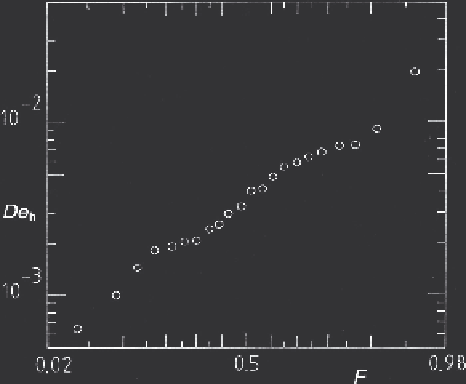Geoscience Reference
In-Depth Information
Fig. 10.35 Distribution of the hydraulic desorptivity (in m
2
s
−
1
/
2
) defined in Equation (10.59) and calculated by
means of (10.173) from the same river flow data and plotted as in Figure 10.34. (From Brutsaert and
Lopez, 1998.)
Figures 10.36 and 10.37 show the ranges of values of
k
0
and
n
e
, that were obtained
by means of Equations (10.174) in the Washita River watershed. The values of these two
parameters obtained with this method appear to lie well within the accepted ranges for
field measurements in other studies. It is also not surprising that the hydraulic conduc-
tivities are several orders of magnitude larger than values to be expected on the basis of
laboratory measurements or by “sandbox” standards. This is because of macropores and
preferential flow paths that become operative at larger spatial scales. More importantly,
however, the values shown in the figures are within a reasonable range from one another;
this suggests that the arguably oversimplified hydraulic approach and the method of
slope analysis can serve a useful purpose.
The same study also showed that the characteristic outflow time (
a
3
)
−
1
(
K
) is well
correlated with spatial scale
L
, that is the length of all stream channels in the basin;
the obtained correlation coefficient was
r
=
=
.
0
66. This is not unexpected in light of
Equation (10.165), but as the drainage density
L
A
does not vary widely in this region,
the predictive power of the relationship between
a
3
and
L
was found to be weak. The
short-time constant
a
1
was found to be strongly related with stream length
L
; actually, the
regression equation was calculated to be
a
1
=−
/
10
3
L
−
1
.
81
(in m) with
r
5
.
46
×
=
0
.
91,
in good agreement with the
L
dependency in Equation (10.161). If the power of
L
is assumed to be exactly the same as in (10.161), the resulting median line through the
data is
−
10
4
L
−
2
a
1
=−
3
.
50
×
(10.175)
As illustrated in Figures 10.36 and 10.37, use of Equation (10.175) can constrain the
erratic behavior of
a
1
somewhat, and it results in considerably less variation (or scatter) in

